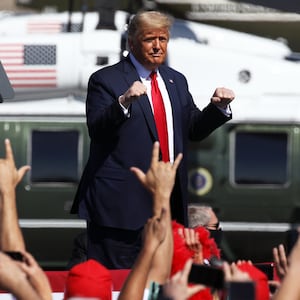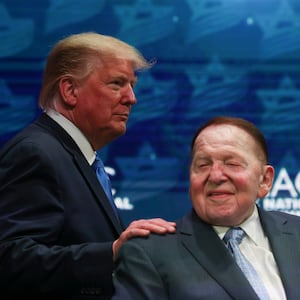Through creative accounting and a little-known quirk in campaign finance laws, President Donald Trump and Republican state parties have shuffled around millions of dollars in financial contributions in ways that effectively evade limits on the amount of money top donors can put up to finance the 2020 presidential campaign.
His Democratic challenger Joe Biden has done it too, but without constructing the labyrinthine web of transactions that Trump has.
Both presidential candidates have used political groups known as joint fundraising committees (JFCs) to solicit huge contributions from their top supporters. In theory, those contributions are supposed to be divided among the respective campaigns and the various state and national party organs that are part of the joint fundraising agreement—with the breakdown in cash falling along the legally prescribed limits on how much an individual can donate to each entity.
ADVERTISEMENT
But both candidates have taken full advantage of a legal loophole that allows participating entities in the JFC to essentially funnel their slice of the pie back to the national party or other state parties. The result has been a financial windfall for political committees that are at the frontlines of the presidential election.
For Trump, who previously criticized the same sorts of tactics, the scheme is working to the benefit of the Republican National Committee, which received more than $13 million last month through transfers involving its JFC. Biden is doing something similar, but instead of steering the money to the national Democratic Party, his political machine appears to be using the technique to lavishly fund state parties in crucial battleground contests.
“At a minimum, it’s an evasion of contribution limits. It may or may not be a violation," according to Paul S. Ryan, the vice president of litigation for the group Common Cause. “Both Congress and the Federal Election Commission have a responsibility to strengthen our campaign finance laws to prevent this type of abuse.”
The end-run around contribution limits enabled by joint fundraising committees is by now a well-known accounting gimmick among experts who track campaign finance closely. But for Trump’s political machine, it appears to be just one part of a convoluted series of financial exchanges between the national party, its state affiliates, the Trump campaign itself, and the fundraising vehicle set up to finance them all.
The precise nature of the transfers is not immediately clear from public records. But experts described the arrangement as unusual. And what numbers are in the public domain suggest that there is more to it than the standard JFC-enabled shell game now common among deep-pocketed presidential campaigns and national party committees. One top Democratic official called the paper trail “baffling.”
Under current law, individuals can generally donate up to $5,600 per election cycle to a federal political candidate, $2,800 for a primary contest and another $2,800 for a general election. They can also give $35,500 per year to a national party, and $10,000 per year to a state party. Joint fundraising committees allow those contribution limits to be stacked, meaning a donor can write one check totalling the amount he or she would have otherwise had to give to the candidate, the national party, and the state party individually.
The more beneficiaries a JFC has, the larger the checks it can receive. It then distributes those checks among the various committees under its umbrella.
The Trump campaign’s JFC is massive. Called Trump Victory, its beneficiaries currently include the campaign, the Republican National Committee, and 46 state parties. The large number of committees to which Trump Victory distributes the money it raises means its donors can give the group up to $817,800, or roughly 23 times what they’d be able to donate to the RNC directly.
In theory, max-out donations to the JFC are divided up among the entities that are party to it, according to a prescribed formula posted publicly on Trump Victory’s online donation page. But political parties can shuffle money between their various state and federal affiliates without limitation. Trump Victory, like other JFCs before it, has capitalized on that fact to funnel huge portions of its money through the state parties and back to the RNC.
On Sept. 4, Trump Victory made its first distributions of the cycle to those state affiliates, disbursing a total of roughly $13.3 million to 21 of its state party beneficiaries. On the same day, all of those state parties immediately routed the precise sums they’d received from Trump Victory back to the RNC, according to the latter’s most recent FEC filing on Tuesday.
In practice, those transfers effectively allowed financial backers to circumvent individual contribution limits. Donors like casino mogul Sheldon Adelson or his wife Miriam, both of whom gave the legal maximum to Trump Victory in February, had maxed out to the RNC by virtue of their contributions to the JFC. But when the state parties transferred the money they’d received back to the national party headquarters, the Adelsons and other mega-donors were able to effectively fund the RNC at much higher rates. All it takes for it to be legal is for the state parties to take possession of the money first—if only for a matter of hours—before they transfer the funds back to the national party. The quick cash detour through the state party, in effect, washes it of limits on the original donor’s contribution.
In Trump Victory’s case, all 21 of the state parties that got distributions from the JFC last month got the checks on Sept. 4. On the same day, all 21 wrote checks for the exact sums they’d received—down to the penny—back to the RNC. But the FEC filings revealing those transfers also raised additional questions about the financial relationships with the Trump re-elect machinery. .
In addition to the Trump Victory contributions that the state parties sent back to the RNC, both the campaign and the national party reported sending huge checks to a number of state parties last month.
That’s where the dizzying web of Trumpworld financial transfers gets really convoluted. The Florida GOP, for instance, took its $920,091 contribution from Trump Victory on Sept. 4, and immediately cut the RNC a check for the same sum. But less than two weeks later, the RNC made its first of three contributions last month to the Florida party, eventually donating more than $6.1 million.
It was not immediately clear why the RNC would be bankrolling state parties directly after pocketing their Trump Victory money. Even more curious is the money that the Trump campaign itself is transferring to the state parties. The campaign reported donating to 17 of them in September, all in battleground states. All but one of them had also received money from Trump Victory—money it immediately passed on to the RNC.
The Trump campaign’s contributions to state parties in September totaled $13,351,500, which was almost exactly what Trump Victory had steered to the RNC by way of state parties during the same period.
In other words, a number of state parties took in money through the joint fundraising agreement, only to then send it directly to the RNC, only to then receive transfers of money from both the RNC and the Trump campaign.
Campaign veterans said that while it was normal for a national party to fund state affiliates, it was highly irregular for a presidential campaign to do so. Those operations generally want to centralize messaging, operations, and resources under their roof. That’s especially true for Trump, who now finds himself in a significant cash crunch vis-a-vis Biden—a crunch not helped by all the money his campaign sent to state parties.
The Trump campaign would not address detailed questions about the nature of those financial transfers. “The Trump campaign has all the resources we need going into the home stretch of this election. We’re running a comprehensive campaign that incorporates our massive ground game, travel to key states, and ads on digital, TV, and radio,” is all that Samantha Zager, the campaign’s Deputy National Press Secretary, would say.
While the Trump campaign’s financial transactions are shrouded in some mystery, its use of a joint fundraising committee is hardly unique. Among campaign finance obsessives, such committees have come to be known as “super joint fundraising committees.” The scale of the practice is a result of a 2014 Supreme Court decision in McCutcheon v. FEC, in which the court struck down “aggregate” contribution limits, which limited the amounts of money that single donors could give to all federal political committees in a single cycle.
Few exploited that structure more effectively than Hillary Clinton during her 2016 presidential campaign. Clinton’s joint fundraising committee, the Hillary Victory Fund, sent tens of millions of dollars to state parties that was immediately routed back to the Democratic National Committee. After the election, former DNC chair Donna Brazile wrote a book alleging that the Clinton campaign had effectively controlled the flows of money from the HVF, and orchestrated what Republican campaign finance attorney Dan Backer called, in an FEC complaint, an illegal “money laundering” scheme.
Ironically, Backer was the same attorney who successfully represented Shaun McCutcheon, the conservative activist whose Supreme Court case paved the way for the super JFC.
Clinton’s use of a JFC drew particular pointed criticism from Sen. Bernie Sanders’ campaign, which alleged that it was compelling evidence that the DNC had its thumb on the scales for her candidacy. A Clinton aide recalled that the attacks hurt her among the senator’s supporters, even though they believed them to be unfair.
“Both candidates were offered the opportunity [to set up JFCs],” the aide noted, “and the money couldn’t be used in the primary campaigns anyways.”
Among those who didn’t appreciate this nuance was Trump, who seized on the Brazile book to urge the Department of Justice and the FBI to investigate Clinton. But Trump himself was engaged in a similar pattern of transactions as well back in 2016. Nearly all of the roughly $30 million that Trump Victory distributed to state parties during the final four months of that election cycle was almost immediately transferred to back the RNC.
Four years later, campaign veterans say it would be malpractice if candidates didn’t take advantage of this structure. “Both sides would be stupid if they weren’t doing this,” said one Democratic operative. And, indeed, Joe Biden’s campaign does appear to be exploiting the same loophole in campaign finance laws. But it is doing it to slightly different effect and in a way that underscores some fundamental distinctions between Democratic and Republicans tactics this year.
Biden’s joint fundraising committee, the Biden Victory Fund, transferred nearly $35 million to state parties in the third quarter of 2020, according to the group’s most recent FEC filing. But very little of that money was transferred back to the DNC. Instead, a number of the state parties immediately cut checks to different state parties for almost precisely the sums they’d received from the BVF.
The beneficiaries were generally Democratic state parties that are playing crucial roles in Biden’s campaign. On Sept. 21, for instance, the Maryland Democratic Party got $1,285,000 from the BVF. On the same day, it passed along that exact sum to the Democratic Party of Michigan. On Sept. 10, Massachusetts Democrats got $1.2 million from the BVF and immediately passed it along to the Florida state party. The New Jersey Democratic Party received $1,026,000 on September 29. On the same day, it sent $425,000 to Nevada, $355,000 to Iowa, $145,500 to New Hampshire, and $100,000 to Pennsylvania.
The bulk of the BVF’s state party transfers came in September. And while only some of them passed along BVF money to other state parties—of the 46 state parties that got BVF money in September, just 15 transferred cash to other state parties—FEC data show that more than $9 million of money provided by the BVF was immediately transferred to other parts of the country. With few exceptions, those transfers came from states where the presidential contest is not expected to be competitive and went to states that will be crucial in determining the outcome of the presidential contest.









